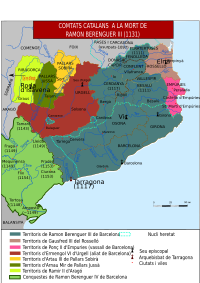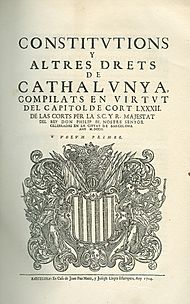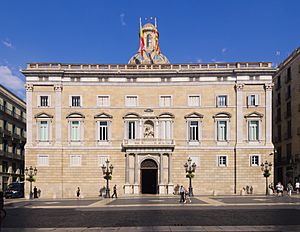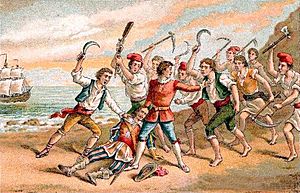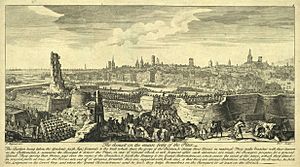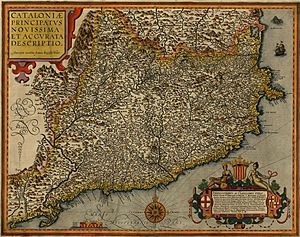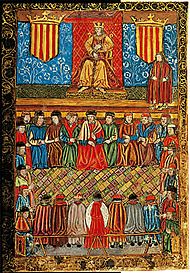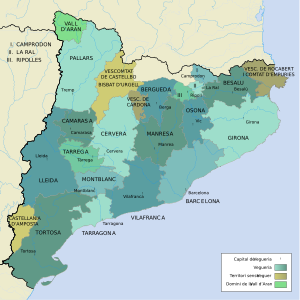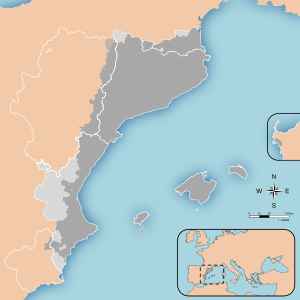Principality of Catalonia facts for kids
Quick facts for kids
Principality of Catalonia
|
|||||||||||||||||||||||||||||
|---|---|---|---|---|---|---|---|---|---|---|---|---|---|---|---|---|---|---|---|---|---|---|---|---|---|---|---|---|---|
| 12th century – 1714/1833 | |||||||||||||||||||||||||||||
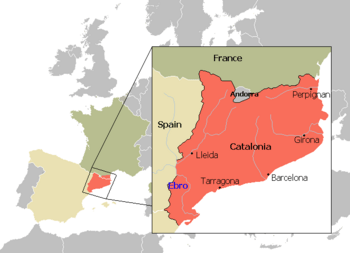
Territory of the Principality of Catalonia until 1659. Location superimposed to current borders
|
|||||||||||||||||||||||||||||
| Status |
|
||||||||||||||||||||||||||||
| Capital | Barcelona | ||||||||||||||||||||||||||||
| Common languages |
|
||||||||||||||||||||||||||||
| Religion |
|
||||||||||||||||||||||||||||
| Government | Monarchy with special laws | ||||||||||||||||||||||||||||
| Count | |||||||||||||||||||||||||||||
|
• 1162–1196
|
Alfons I (first) | ||||||||||||||||||||||||||||
|
• 1706–1714
|
Charles III (last) | ||||||||||||||||||||||||||||
| President of the Deputation | |||||||||||||||||||||||||||||
|
• 1359–1362
|
Berenguer de Cruïlles (first) | ||||||||||||||||||||||||||||
|
• 1713–1714
|
Josep de Vilamala (last) | ||||||||||||||||||||||||||||
| Legislature | Catalan Courts | ||||||||||||||||||||||||||||
| Historical era | Medieval / Early modern | ||||||||||||||||||||||||||||
|
• Rule of Alfons I
|
1164–1196 | ||||||||||||||||||||||||||||
|
• First Catalan constitutions
|
1283 | ||||||||||||||||||||||||||||
|
• Generalitat formed
|
1359 | ||||||||||||||||||||||||||||
|
• Rule of Charles I
|
1516–1556 | ||||||||||||||||||||||||||||
| 1659 | |||||||||||||||||||||||||||||
| 1701–1714 | |||||||||||||||||||||||||||||
| Population | |||||||||||||||||||||||||||||
|
• 1700
|
c. 500,000 | ||||||||||||||||||||||||||||
| Currency | Croat, Ducat, Florin, and other coins | ||||||||||||||||||||||||||||
|
|||||||||||||||||||||||||||||
| Today part of | |||||||||||||||||||||||||||||
The Principality of Catalonia (in Catalan: Principat de Catalunya) was a historic state in the northeastern part of the Iberian Peninsula. It existed during the Middle Ages and the early modern period. For most of its history, it was linked to the Kingdom of Aragon. Together, they formed the Crown of Aragon.
From the 1200s to the 1700s, Catalonia shared borders with the Kingdom of Aragon to the west and the Kingdom of Valencia to the south. To the north were the Kingdom of France and Andorra. The Mediterranean Sea was to its east. The name "Principality of Catalonia" was officially used until the 1830s. At that time, the Spanish government changed how regions were divided. Today, the term Principat is mostly used to talk about the autonomous community of Catalonia in Spain. It helps tell it apart from other Catalan-speaking areas.
The first time "Catalonia" and "Catalans" were mentioned was in a book called Liber maiolichinus de gestis Pisanorum illustribus. This book was written between 1117 and 1125. It described the conquest of Majorca by a group that included Italians, Catalans, and Occitans. Back then, Catalonia was not yet a single political area. However, the name showed that people recognized it as a cultural or geographical place.
The different counties that later formed the Principality of Catalonia slowly came under the rule of the count of Barcelona. In 1137, the County of Barcelona and the Kingdom of Aragon joined under one ruling family. This created what historians now call the Crown of Aragon. Even so, Aragon and Catalonia kept their own political systems and laws. They grew into separate political communities over the centuries.
Under Alfons I the Troubadour (who ruled from 1164 to 1196), Catalonia was first seen as a legal entity. But the term "Principality of Catalonia" wasn't used officially until the 1300s. It was then used for the lands governed by the Catalan Courts.
Catalonia's government system grew over time. It created political groups similar to those in other kingdoms of the Crown. These included the Courts, the Generalitat, and the Consell de Cent. It also had its own laws, called Catalan constitutions. These laws limited the king's power and supported a system where power was shared. Catalonia helped the Crown's trade and military, especially its navy. The Catalan language also grew and spread as more lands joined the Crown. These included Valencia, the Balearic Islands, Sardinia, Sicily, Naples, and Athens. This created a powerful sea empire across the Mediterranean.
However, the 1300s brought many problems. The ruling family of Barcelona ended in 1410. A civil war (1462–1472) also weakened Catalonia's role in the Crown and in international affairs.
In 1469, Ferdinand II of Aragon and Isabella I of Castile married. This marriage set the stage for the monarchy of Spain. In 1492, Spain began to explore and settle the Americas. Political power then started to move away from Aragon and towards Castile. Disagreements between Catalan institutions and the monarchy, along with peasant revolts, led to the Reapers' War (1640–1659).
By the Treaty of the Pyrenees in 1659, the Roussillon region was given to France. During the War of the Spanish Succession (1701–1714), the Crown of Aragon supported the Archduke Charles of Habsburg. After Barcelona surrendered in 1714, King Philip V of Bourbon took control. He introduced a new system, the Nueva Planta decrees. These decrees removed the main Catalan, Aragonese, Valencian, and Majorcan political institutions and rights. They merged them into the Crown of Castile as provinces. However, the Principality of Catalonia remained an administrative unit until 1833. At that time, Catalonia was divided into four provinces.
Contents
History of Catalonia
Early Beginnings
Like much of the Mediterranean coast of Spain, Catalonia was first settled by Ancient Greeks. They chose to live in places like Roses. Both Greeks and Carthaginians traded with the local Iberian people. After the Carthaginians were defeated, the area became part of the Roman Empire. Tarraco was an important Roman city and the capital of the Tarraconensis province.
The Visigoths ruled after the Western Roman Empire fell in the late 400s. Moorish forces from Al-Andalus took control in the early 700s. This happened after they conquered the Visigothic kingdom between 711 and 718. After a battle in Tours in 732, the Franks slowly took control of the Visigoth lands north of the Pyrenees mountains.
In 795, Charlemagne created the Marca Hispanica. This was a buffer zone made of separate local counties. It acted as a defensive barrier between the Umayyad empire in Al-Andalus and the Frankish Kingdom.
A unique Catalan culture began to grow in the Middle Ages. It came from these small counties in northern Catalonia. The counts of Barcelona were Frankish vassals. They were chosen by the Carolingian emperor. In 878, Wilfred the Hairy became count of Barcelona, Girona, and Osona. From then on, these three counties were always ruled by the same person. They became the political heart of the future Principality of Catalonia. When Wilfred died in 897, he made these titles hereditary. This started the House of Barcelona family, which ruled Catalonia until 1410.
Many monasteries were built between the 800s and 1100s. Churches were also rebuilt in cities. These religious centers became important places for art and learning. They helped spread Romanesque art in Catalonia. They also kept rich libraries with old Roman, Visigothic, and Arab books.
In 988, Count Borrell II stopped recognizing the Frankish king. This effectively made Barcelona independent from Frankish rule. From this time, the counts of Barcelona often called themselves princeps (prince). This showed their importance over the other Catalan counts.
During the 1000s, the Catalan Counties saw a rise in feudalism. Lords created vassal relationships over previously independent peasants. The middle of the century had strong class conflicts. Lords used new military tactics against peasants. By the end of the century, most free farmers had become vassals.
The Catholic Church tried to stop this violence. They created "sagreres" around churches and started the Peace and Truce of God movement. The first meeting for Peace and Truce was held in Roussillon in 1027. Count Ramon Berenguer I began to write down Catalan laws. These were called the Usages of Barcelona. They became the first full collection of feudal law in Western Europe.
Under Count Ramon Berenguer III, the County of Barcelona expanded its territory. This included a joint effort with Pisa to conquer Majorca in 1114. They also conquered Tarragona in 1116. This restored the important church leadership in Tarragona. It meant the Catalan Church became independent from the bishopric of Narbonne.
Joining the Crown of Aragon
In 1137, Count Ramon Berenguer IV of Barcelona married Queen Petronilla of Aragon. This marriage joined the County of Barcelona and its lands with the Kingdom of Aragon. This union created the Crown of Aragon. Ramon Berenguer IV's rule saw the Catalan conquest of Lleida and Tortosa. Their son, Alfons, was the first king of Aragon who was also the count of Barcelona. All future kings of the Crown of Aragon inherited these titles.
During Alfons's rule in 1173, Catalonia was officially defined for the first time. The first collection of the Usages of Barcelona was also made. This was done to make them the official law of Catalonia.
His son, King Peter II of Aragon, had to defend the Occitan territories. These lands had been gained since the time of Ramon Berenguer I. They were threatened by the Albigensian Crusade. The Battle of Muret in 1213 was a big defeat for King Peter. This battle led to the weakening of strong ties between Catalonia and the Languedoc region.
In the Treaty of Corbeil (1258), James I of Aragon gave up his family's rights in the Languedoc. He recognized the French king Louis IX as the heir of the Carolingian dynasty. In return, the French king officially gave up his claims over all the Catalan counties. This treaty confirmed the independence of the Catalan counties. But it also meant a permanent separation between the people of Catalonia and the Languedoc.
As a coastal area within the Crown of Aragon, Barcelona became a very important port. Catalonia became the main center of the Crown's sea power. It helped expand its influence and power by conquering and trading with Valencia, the Balearic Islands, Sardinia, and Sicily.
Catalan Laws and the 1400s
At the same time, the Principality of Catalonia developed a complex political system. It was based on an agreement between the different groups of society and the monarch. Laws, called constitutions, had to be approved by the General Court of Catalonia. This was one of the first parliaments in Europe. It stopped the king from making laws alone, sharing this power with the groups represented in the Court (since 1283). The first Catalan constitutions came from the Usages of Barcelona in 1283. These constitutions protected the rights of people in the Principality and limited the power of the kings.
The General Court of Catalonia (or Catalan Courts) started in the 11th century. Since 1283, it had the power to create laws with the monarch. The Courts had three groups, called "arms." The monarch, as count of Barcelona, led them. Today's Parliament of Catalonia is seen as the modern version of this institution.
To collect a "General tax," the Courts in 1359 created a group of deputies. This group was called the Deputation of the General, later known as the Generalitat. It gained a lot of political power over the next centuries.
The Principality had a good period during the 1200s and early 1300s. The population grew, and the Catalan language and culture spread. The rule of Peter III of Aragon ("the Great") included conquering Sicily. He also successfully defended against a French crusade. His son Alfonso III ("the Generous") conquered Menorca. Peter's second son, James II, conquered Sardinia. Barcelona became the administrative center of the lands. The Catalan Company, a group of soldiers, was hired by the Byzantine Empire to fight the Turks. They even conquered the duchies of Athens and Neopatras for the King of Aragon. Catalan rule in Greek lands lasted until 1390.
This expansion also led to a great growth in Catalan trade. Barcelona was the center, creating a large trade network across the Mediterranean. This network competed with those of Genoa and Venice. New institutions were created to protect merchants, like the Consulate of the Sea.
The mid-1300s brought big changes to Catalonia. There were natural disasters, population drops, and economic problems. Social tensions also grew. The year 1333 was called Lo mal any primer ("The first bad year") because of a poor wheat harvest. The Black Death also hit the Aragonese Crown's lands hard. Between 1347 and 1497, Catalonia lost 37 percent of its people.
In 1410, King Martin I, the last ruler from the House of Barcelona, died without children. The Compromise of Caspe (1412) then gave the Crown of Aragon to Ferdinand from the Castilian House of Trastámara. Ferdinand's successor, Alfonso V ("the Magnanimous"), started a new period of expansion. This time, it was over the Kingdom of Naples. However, he made the social problems in Catalonia worse, both in the countryside and cities.
Political conflict grew in Barcelona. Two groups, Biga and Busca, argued over control of the Consell de Cent. They wanted to solve the economic crisis. Meanwhile, the "remença" peasants, who suffered from feudal abuses, started to organize. They sought protection from the king.
King John II ("the Unreliable") was deeply disliked. The Catalan institutions opposed his policies. They supported John's son, Charles, Prince of Viana. When John arrested Charles, the Generalitat formed a political body, the Council of the Principality. John was forced to negotiate. The Capitulation of Vilafranca (1461) forced Charles's release. It also made him lieutenant of Catalonia. The king needed permission from the Generalitat to enter Catalonia. This agreement showed how strong Catalonia's constitutional system had become.
However, King John disagreed with the terms. Charles died soon after. The Remença Uprising in 1462 led to the ten-year Catalan Civil War (1462-1472). This war left the country exhausted. In 1472, the last separate ruler of Catalonia lost the war against King John.
John's son, Ferdinand II of Aragon ("the Catholic"), got back the northern Catalan counties in 1493 without war. He also greatly reformed Catalan institutions. The Constitució de l'Observança (1481) was approved. This law made the king's power subject to the laws approved in the Catalan Courts. After years of conflict, the remença peasants were freed from most feudal abuses by the Sentencia Arbitral de Guadalupe (1486). They had to pay a fee in return.
Catalonia in the Early Modern Period
The marriage of Isabella I of Castile and Ferdinand II of Aragon in 1469 united two of the three major Christian kingdoms in Spain. The Kingdom of Navarre was added later. This strengthened the idea of "Spain," which included the former Crown of Aragon, Castile, and Navarre. In 1492, the last part of Al-Andalus around Granada was conquered. Spain also began to explore and settle the Americas. Political power started to move from Aragon to Castile. Spain then became a large empire, often fighting wars in Europe.
In 1516, Charles I of Spain became the first king to rule both Castile and Aragon at the same time. He was also elected Charles V, Holy Roman Emperor, in 1519. Charles V's rule was a peaceful time. Catalonia generally accepted the new structure of Spain, even though it became less central.
For a long time, Catalonia kept its own government system and laws. This was different from other parts of southern and central Europe. There, representative institutions lost power. Catalonia's institutions were finally removed after losing the War of the Spanish Succession in the early 1700s. The kings often lived in Castile, far from Catalonia. This led to the viceroy becoming the king's main representative in Catalonia.
Over the next two centuries, Catalonia was often on the losing side of wars. These wars led to more power being centralized in Spain. Despite this, between the 1500s and 1700s, local communities and the government gained more power in Catalonia. The king's powers remained limited, especially after the last two Courts (1701–1702 and 1705–1706).
Disagreements grew between Catalonia's institutions and the increasingly centralized monarchy. In 1626, the Count-Duke of Olivares, a minister for Philip IV, tried to make all parts of the monarchy contribute soldiers. This was called the Unión de Armas (Union of Arms). But Catalonia strongly resisted this plan. These events, along with economic problems, the presence of soldiers, and peasant revolts, led to the Reapers' War (1640–1652). This war was part of the Franco-Spanish War.
During this war, Catalonia, led by Pau Claris, briefly declared itself an independent republic under French protection in January 1641. It later joined the French monarchy, making King Louis XIII count of Barcelona. However, after some early military successes, the Catalans were defeated. They rejoined the Crown of Spain in 1652.
In 1659, after the Treaty of the Pyrenees, some Catalan areas were given to France. These included Roussillon, Conflent, Vallespir, and part of Cerdanya. The town of Llívia remained part of Spain, as an isolated area. Catalan institutions were removed in the French part of the territory. In 1700, public use of the Catalan language was forbidden there. Today, this area is known as Northern Catalonia and is part of the French Pyrénées-Orientales region.
In the late 1600s, during the rule of Spain's last Habsburg king, Charles II, Catalonia's population grew to about 500,000 people. The Catalan economy also recovered. This growth was helped by exporting wine to England and the Dutch Republic. Many Catalans started to see England and the Netherlands as good examples for Catalonia.
At the start of the War of the Spanish Succession, the Bourbon Duke of Anjou claimed the Spanish throne as Philip V. Catalonia first supported him. However, the viceroy's harsh actions and the king's authoritarian decisions made Catalonia change sides in 1705. The Habsburg candidate, the Archduke Charles of Austria, landed in Barcelona. Catalonia and England signed the Pact of Genoa that year. Catalonia received protection for its institutions and freedoms.
The Treaty of Utrecht (1713) ended the war. The allied armies left Catalonia. But Catalonia continued fighting with its own army until Barcelona fell on September 11, 1714. King Philip V's army occupied Barcelona. In 1716, the king enacted the Nueva Planta decrees. These decrees abolished the main Catalan institutions and laws (except civil and trade laws). They established absolutism as the new political system. They also made Spanish the official administrative language, slowly replacing Catalan.
After the Nueva Planta Decrees
The Nueva Planta decrees not only removed Catalan institutions but also changed the Royal Audience of Catalonia. It became the highest government body. It took over many tasks of the abolished institutions. It became the tool for the Captain General of Catalonia to govern. The Captain General was the supreme authority, chosen by the king. The old division into vegueries was replaced by Castilian corregimientos.
Even with military occupation and new high taxes, Catalonia continued to grow economically in the 1700s and 1800s. This was helped by new trade with America and protectionist policies. Catalonia became a center of Spain's industrialization. Today, it remains one of the most industrialized parts of Spain. In 1833, Spain was divided into provinces. Catalonia was split into four provinces: Barcelona, Girona, Lleida, and Tarragona. These provinces did not have a common administration.
In the early 1900s, Catalonia gained and lost some self-rule several times. It regained administrative unity in 1914. The four Catalan provinces were allowed to create a commonwealth. After the Second Spanish Republic was declared in 1931, the Generalitat was restored. It became an institution for self-government. However, after the Spanish Civil War (1936–1939), which brought Francisco Franco to power, Catalan self-rule and culture were severely suppressed. Public use of the Catalan language was again banned.
The Franco era ended with his death in 1975. During the change to democracy, Catalonia regained political and cultural self-rule. It became one of the autonomous communities of Spain. Northern Catalonia in France, however, still has no self-rule.
What is a Principality?
The counts of Barcelona were often seen as the princeps or "first among equals" by other counts. This was because of their military and economic power. Barcelona was also more important than other cities.
For example, Count Ramon Berenguer I was called "Prince of Barcelona" in 1058. The Usages of Barcelona, a collection of laws, also mentioned the "Prince." Usage #64 called the group of counties of Barcelona, Girona, and Ausona a principatus. These were all under the count of Barcelona's authority.
The first official mention of Principat de Cathalunya was in 1343. It was used again in 1350 for the Catalan Courts in Perpignan. This term showed that the land under these laws was not a kingdom. Instead, it was an expansion of the territory ruled by the Count of Barcelona, who was also the King of Aragon.
The terms Catalonia and Catalans were commonly used for the region and its people since the early 1100s. This is shown in early writings like the Liber Maiolichinus.
The name "Principality of Catalonia" is found in many historical documents from the mid-1300s to the early 1800s. Historians believe that the Catalan counties became a single political area in the late 1100s. This happened because the counts of Barcelona became the main rulers of most Catalan Counties. They also became kings of Aragon. This helped them gain power over other Catalan counts. They also added Muslim lands like Tortosa and Lleida to their large domain.
The political area that resulted was often called a "kingdom" in the Middle Ages. However, the rulers of the Kingdom of Aragon never used the title "King of Catalonia." This is why the term "principality" was used. Since the 1100s, "principality" was a general term for political areas ruled by a monarch. It became an official and popular name around 1350. This political area was part of larger monarchies, like the Crown of Aragon and the Spanish monarchy. It was equal to other political communities of the time.
After the Nueva Planta decrees in 1716, Catalonia became a province of the new Kingdom of Bourbon Spain. But "principality" continued to define the territory. For example, the decrees created the Royal Audience of the Principality of Catalonia in 1716. This lasted until 1833. At that time, Spain became a liberal state. The territory was divided into four provinces, and the term "principality" disappeared from official use. Today, it is still used by some Catalan nationalists.
Government and Law
The political system of the Principality of Catalonia was based on "pactism." This means there was an agreement between the king and the kingdom. This agreement greatly limited the king's power.
Key Institutions
- General Court of Catalonia (or Catalan Courts): This was the main parliamentary body. It started in the 1200s. The monarch called and led it. It had representatives from three social groups. It passed laws and gave money to the Crown. It also advised the king and was a place for justice.
- Deputation of the General (or Generalitat de Catalunya): This was a permanent council of deputies. It was created in 1359 to collect taxes. Over time, it gained political power and became very important. It had three deputies and three auditors.
- Consell de Cent de Barcelona (Council of One Hundred of Barcelona): This was the government of Barcelona. It was created during the rule of James I. The city was run by five, later six, counselors. They were chosen by a council of one hundred people.
- Royal Audience and Royal Council of Catalonia: This was Catalonia's highest court of justice and government seat. It was set up in 1493. Its members were chosen by the king.
- Conference of the Three Commons: This was a meeting of the Generalitat, the Military Estate, and the Council of One Hundred of Barcelona. They met in the 1600s and 1700s to discuss Catalonia's political issues.
- Junta de Braços (Council of Arms): This was a special parliamentary council called by the Generalitat. It included representatives from the Catalan Courts who were in Barcelona. It acted like the Courts but did not formally have law-making powers.
- Court of Contraventions: This court was set up in 1701–1702. Its job was to make sure the constitutions were followed. It also dealt with actions against Catalan law, even by the king. Its members were chosen equally by the local institutions and the king. This was a big step for protecting individual rights.
Important Laws
- Usages of Barcelona: These were a collection of customs and laws. They were based on Roman and Visigothic law from the County of Barcelona. They were used throughout the Principality and formed the basis for the Catalan constitutions.
- Catalan constitutions: These were laws made by the king and approved by the Catalan Courts. They were the most important laws and could only be changed by the Courts themselves.
- Chapters of Court: These were laws made by the Courts and approved by the king.
- Acts of Court: These were smaller laws and decrees made by the Courts. They did not need the king's formal approval.
Royal Officers
- Lieutenant or Viceroy of Catalonia: This person represented the king in Catalonia from the 1400s to the 1700s. They had the same status as the monarch. Catalan laws allowed non-Catalans to be viceroys.
- Portantveus de General Governador: This was the highest official in the royal administration. Their main job was to manage justice across the territory. When the king died, they took over royal duties until a new king was sworn in.
- Mestre Racional: This royal official was in charge of accounting for the Principality. They recorded the royal family's income and expenses. The Mestre Racional of Catalonia also oversaw the kingdoms of Majorca and Sardinia.
Vegueries: Local Divisions
A vegueria was a local area in Catalonia. It was led by a veguer. The idea of the vegueria came from the Carolingian Empire. Back then, "vicars" were placed under the counts in the Marca Hispanica.
The veguer was chosen by the king and reported to him. They were the military leader of their vegueria. They were also the chief judge and managed the region's public money. Over time, the veguer's job became more about justice. They held a court that dealt with civil and criminal cases. The veguer also kept some military duties. They commanded the local militia and oversaw royal castles. Their main job was to keep law and order.
Some larger vegueries had smaller sotsvegueries (sub-vegueries). These had a lot of independence. By the late 1100s, Catalonia had 12 vegueries. By 1285, there were 17, and by the time of James the Just, there were 21. After France took some vegueries in 1659, Catalonia had 15 vegueries, 9 sotsvegueries, and the special district of the Val d'Aran. These divisions lasted until 1716. Then, they were replaced by the Castilian corregimientos.
Military and Defense
The law Princeps namque, from the 11th century, set rules for defending the prince and the Principality. This law became the basis for self-defense groups throughout Catalan history. These groups were called Sagramental, and the local militia was known as Sometent.
The feudal system allowed lords, institutions, and groups to raise their own armies. The king could also call on them due to feudal agreements. However, there was no permanent army. Catalan soldiers were important in expanding the Crown into Valencia, Majorca, and the Mediterranean. The Catalan navy and its galleys helped expand and secure control over the sea. The army used many resources to conquer Sardinia and fight in the War of the Sicilian Vespers. After that war, many Almogavers (light infantry soldiers) became mercenaries. They formed the Great Catalan Company in 1303.
During the Catalan Civil War (1462–1472), the Council of the Principality of Catalonia organized different military forces to fight King John II. This war saw one of the first widespread uses of firearms in a European conflict. In 1493, King Ferdinand II confirmed the Princeps namque law.
After the Spanish monarchy was formed in the 1500s, Catalans served in the Habsburg military. However, the Princeps namque law and a smaller population limited their numbers compared to other parts of the Empire. Some cities like Barcelona gained the right to self-defense and formed urban militias called the Coronela. During conflicts with France, many Catalan militias fought alongside the regular army, such as in the siege of Salses in 1639.
Symbols of Catalonia
Catalonia, as a state under royal rule, did not have its own flag or coat of arms in the modern sense. However, various royal and other symbols were used to identify the Principality and its institutions.
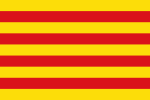 |
The Senyera is one of Europe's oldest flags still used today. There are different ideas about whether it started in Catalonia or Aragon. It was the monarch's personal symbol. But over time, it also came to represent the different parts of the Crown of Aragon, including the Principality of Catalonia. |
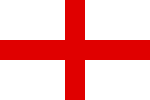 |
St George's flag was used by the Deputation of the General (Generalitat) and its army. |
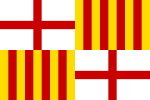  |
This is the Flag of Barcelona, the capital. It first appeared in 1329. In 1335, King Peter IV allowed the Council of One Hundred to use his royal symbol (the four bars). The number of bars varied between 2 and 4 for a long time. It was later replaced by the Saint Eulalia's flag. This flag also appeared on some maps to identify the Principality. |
  |
These were the royal arms of the king of Aragon and count of Barcelona. |
 |
The St George Cross was used as a symbol by the Deputation of the General (Generalitat). |
Language and Culture
Catalonia is where the Catalan language first developed. Catalan shares features with other Romance languages. Some linguists see it as an Ibero-Romance language (like Spanish). Most see it as a Gallo-Romance language (like French or Occitan). Catalan separated from Occitan between the 1000s and 1300s.
By the 800s, Catalan had grown from Vulgar Latin on both sides of the eastern Pyrenees. From the 700s, Catalan counts expanded their land south and west. They conquered areas held by Muslims and brought their language with them. In the 1000s, official documents started to show Catalan words. By the late 1000s, documents written mostly in Catalan began to appear.

Catalan had a "golden age" in the Late Middle Ages. It became very developed and culturally rich. It spread as more lands joined the Crown of Aragon. Famous works include those by Ramon Llull (1232–1315) and the The Four Great Catalan Chronicles. Catalan became the main language of the Kingdom of Majorca and the Kingdom of Valencia. It also spread to Sardinia and was used in Sicily and Athens. Between the 1200s and 1400s, Catalan was used across the Mediterranean world. It was one of the first bases for the Mediterranean Lingua Franca, a common trade language.
The Royal Chancery promoted a standard Catalan language. By the 1400s, Valencia became a center for social and cultural activity. The novel Tirant lo Blanc (1490) shows the shift from medieval to Renaissance ideas. The first book printed with movable type in Spain was in Catalan.
When the crowns of Castile and Aragon united in 1479, Castilian (Spanish) became more important. This marked the start of Catalan's decline. In the 1500s and 1600s, Catalan literature was influenced by Spanish. Educated people often spoke both languages. After the War of Spanish Succession (1714), Spanish replaced Catalan in legal documents. It became the official language in Catalonia, Valencia, and Majorca.
Today, Catalan is one of the three official languages of the autonomous community of Catalonia. The other two are Spanish and Occitan (Aranese variety). Catalan is not officially recognized in "Northern Catalonia" in France. Catalan is also official in the Balearic Islands and in the Land of Valencia (where it's called Valencian). It's also official in the city of Alghero in Italy and is the only official language in Andorra.
More to Explore
- List of Counts of Barcelona
- List of presidents of the Generalitat de Catalunya
- List of viceroys of Catalonia
- Royal Archives of Barcelona
- Palau Reial Major
- Catalan Countries
- List of Catalans
- Catalan nationalism
See also
 In Spanish: Principado de Cataluña para niños
In Spanish: Principado de Cataluña para niños



